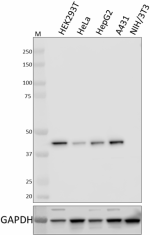- Clone
- W19033A (See other available formats)
- Regulatory Status
- RUO
- Other Names
- ribonucletide-diphosphate reductase subunit M2, ribonucleotide reductase small subunit, RRM2, RNR2
- Isotype
- Rat IgG2b, κ
- Ave. Rating
- Submit a Review
- Product Citations
- publications

-

Whole cell extracts (15 µg total protein) from the indicated cells were resolved by 4-12% Bis-Tris gel electrophoresis, transferred to a PVDF membrane, and probed with 1.0 µg/mL (1:500 dilution) of purified anti-RRM2 antibody (clone W19033A) overnight at 4°C. Proteins were visualized by chemiluminescence detection using HRP goat anti-rat IgG antibody (Cat. No. 405405) at a 1:3000 dilution. Direct-Blot™ HRP anti-GAPDH antibody (Cat. No. 607904) was used as a loading control at a 1:25000 dilution (lower). Lane M: Molecular weight marker. -

Whole cell extracts (250 µg total protein) prepared from HeLa cells were immunoprecipitated overnight with 2.0 µg of purified rat IgG2b, κ isotype ctrl antibody (Cat. No. 400601) or purified anti-RRM2 antibody (clone W19033A). The resulting IP fractions and whole cell extract input (6%) were resolved by 4-12% Bis-Tris gel electrophoresis, transferred to a PVDF membrane and probed with a rabbit control antibody against a separate epitope of RRM2. Lane M: Molecular weight marker.
| Cat # | Size | Price | Quantity Check Availability | Save | ||
|---|---|---|---|---|---|---|
| 937401 | 25 µg | 101 CHF | ||||
| 937402 | 100 µg | 253 CHF | ||||
Ribonucleotide reductase catalyzes the rate-limiting step for de novo deoxyribonucleotide dNTPs synthesis. It is a heterotetramer comprised of two identical large subunits (RRM1) and two identical small subunits (RRM2). The functional ribonucleotide reductase enzyme converts ribonucleotides to dNTPs, which are utilized for DNA synthesis. Ribonucleotide reductase activity requires a high degree of regulation to maintain a proper balance between dNTP availability and DNA synthesis demands. While RRM1 protein levels are generally constitutive, RRM2 expression is cell-cycle regulated at multiple levels. Dysregulation of RRM2 results in dNTP imbalances and increased misincorporation of dNTPs into newly synthesized DNA, and elevated RRM2 levels have been described in multiple forms of cancer. Targeted disruption of RRM2 has been proposed as a mechanism to drive tumors into a senescent state.
Product DetailsProduct Details
- Verified Reactivity
- Human
- Antibody Type
- Monoclonal
- Host Species
- Rat
- Immunogen
- Full-length recombinant human RRM2 protein
- Formulation
- Phosphate-buffered solution, pH 7.2, containing 0.09% sodium azide
- Preparation
- The antibody was purified by affinity chromatography.
- Concentration
- 0.5 mg/mL
- Storage & Handling
- The antibody solution should be stored undiluted between 2°C and 8°C.
- Application
-
WB - Quality tested
IP - Verified - Recommended Usage
-
Each lot of this antibody is quality control tested by western blotting. For western blotting, the suggested use of this reagent is 0.125 - 1.0 µg/mL. For immunoprecipitation, the suggested use of this reagent is 2.0 µg/test. It is recommended that the reagent be titrated for optimal performance for each application.
- Application Notes
-
This clone does not recognize mouse RRM2 by western blot.
This clone was tested for ICC using HeLa cells fixed with 4% PFA and permeabilized with Triton X-100 or methanol; RRM2 staining failed under both conditions. - RRID
-
AB_2876752 (BioLegend Cat. No. 937401)
AB_2876752 (BioLegend Cat. No. 937402)
Antigen Details
- Structure
- RRM2 is a 389 amino acid protein with a predicted molecular weight of 45 kD.
- Distribution
-
Cytosol/Ubiquitously expressed
- Function
- DNA synthesis
- Biology Area
- Cell Biology, Cell Cycle/DNA Replication, DNA Repair/Replication
- Molecular Family
- Enzymes and Regulators
- Antigen References
-
- Zhang K, et al. 2009. Mol Cancer. 8:11.
- Zhang YW, et al. 2009. J Biol Chem. 284:18085-95.
- D’Angiolella V, et al. 2012. Cell. 149:1023-34.
- Gene ID
- 6241 View all products for this Gene ID
- UniProt
- View information about RRM2 on UniProt.org
Related Pages & Pathways
Pages
Related FAQs
Other Formats
View All RRM2 Reagents Request Custom Conjugation| Description | Clone | Applications |
|---|---|---|
| Purified anti-RRM2 | W19033A | WB,IP |
Compare Data Across All Formats
This data display is provided for general comparisons between formats.
Your actual data may vary due to variations in samples, target cells, instruments and their settings, staining conditions, and other factors.
If you need assistance with selecting the best format contact our expert technical support team.
 Login / Register
Login / Register 









Follow Us